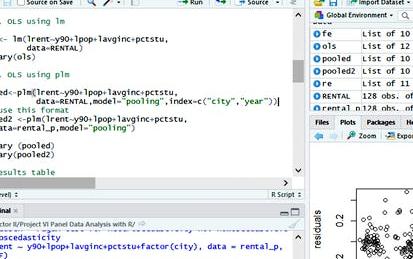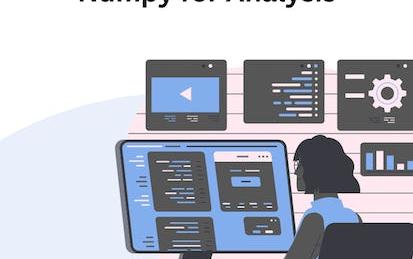

Our Courses

Follow a Machine Learning Workflow
Machine learning is not just a single task or even a small group of tasks; it is an entire process, one that practitioners must follow from beginning to end. It is this process—also called a workflow—that enables the organization to get the most useful results out of their machine learning technologies. No matter what form the final product or service takes, leveraging the workflow is key to the success of the business's AI solution.
-
Course by

-
 Self Paced
Self Paced
-
 20 hours
20 hours
-
 English
English

Supervised Machine Learning: Regression
This course introduces you to one of the main types of modelling families of supervised Machine Learning: Regression. You will learn how to train regression models to predict continuous outcomes and how to use error metrics to compare across different models.
-
Course by

-
 Self Paced
Self Paced
-
 21 hours
21 hours
-
 English
English

Introduction to R Programming and Tidyverse
This course is a gentle introduction to programming in R designed for 3 types of learners. It will be right for you, if: • you want to do data analysis but don’t know programming • you know programming but aren’t familiar with R • you know some R programming but want to learn the tidyverse verbs You will learn to do data visualization and analysis in a reproducible manner and use functions that allow your code to be easily read and understood.
-
Course by

-
 Self Paced
Self Paced
-
 23 hours
23 hours
-
 English
English

Exploratory Data Analysis Using AI Platform
This is a self-paced lab that takes place in the Google Cloud console. Learn the process of analyzing a data set stored in BigQuery using AI Platform to perform queries and present the data using various statistical plot…
-
Course by

-
 Self Paced
Self Paced
-
 English
English

Introduction to R Programming for Data Science
When working in the data science field you will definitely become acquainted with the R language and the role it plays in data analysis. This course introduces you to the basics of the R language such as data types, techniques for manipulation, and how to implement fundamental programming tasks. You will begin the process of understanding common data structures, programming fundamentals and how to manipulate data all with the help of the R programming language. The emphasis in this course is hands-on and practical learning .
-
Course by

-
 Self Paced
Self Paced
-
 11 hours
11 hours
-
 English
English

Panel Data Analysis with R
In this 1-hour long project-based course, you will learn how to conduct Panel Data (Regression) Analysis.
-
Course by

-
 Self Paced
Self Paced
-
 2 hours
2 hours
-
 English
English

Managing Relational Databases
Students will learn about the structure and design of relational databases including primary and foreign key fields, one-to-many and one-to-one relationships. Students will learn about the Structured Query Language (SQL) and use SQL to examine the database structure. They will also learn to create and manage databases, tables, and records. The focus of the course is on data analysis. Students will start with basic SQL queries then learn to add conditional statements, and logical, comparison and arithmetic operators.
-
Course by

-
 Self Paced
Self Paced
-
 18 hours
18 hours
-
 English
English

Introduction to Data Science and scikit-learn in Python
This course will teach you how to leverage the power of Python and artificial intelligence to create and test hypothesis. We'll start for the ground up, learning some basic Python for data science before diving into some of its richer applications to test our created hypothesis. We'll learn some of the most important libraries for exploratory data analysis (EDA) and machine learning such as Numpy, Pandas, and Sci-kit learn.
-
Course by

-
 Self Paced
Self Paced
-
 14 hours
14 hours
-
 English
English

Spatial Data Science and Applications
Spatial (map) is considered as a core infrastructure of modern IT world, which is substantiated by business transactions of major IT companies such as Apple, Google, Microsoft, Amazon, Intel, and Uber, and even motor companies such as Audi, BMW, and Mercedes. Consequently, they are bound to hire more and more spatial data scientists.
-
Course by

-
 Self Paced
Self Paced
-
 12 hours
12 hours
-
 English
English

Network Analysis in Systems Biology
This course introduces data analysis methods used in systems biology, bioinformatics, and systems pharmacology research. The course covers methods to process raw data from genome-wide mRNA expression studies (microarrays and RNA-seq) including data normalization, clustering, dimensionality reduction, differential expression, enrichment analysis, and network construction. The course contains practical tutorials for using several bioinformatics tools and setting up data analysis pipelines, also covering the mathematics behind the methods applied by these tools and workflows.
-
Course by

-
 Self Paced
Self Paced
-
 30 hours
30 hours
-
 English
English

Precalculus: Relations and Functions
This course helps to build the foundational material to use mathematics as a tool to model, understand, and interpret the world around us. This is done through studying functions, their properties, and applications to data analysis. Concepts of precalculus provide the set of tools for the beginning student to begin their scientific career, preparing them for future science and calculus courses. This course is designed for all students, not just those interested in further mathematics courses.
-
Course by

-
 Self Paced
Self Paced
-
 12 hours
12 hours
-
 English
English

Data Analysis in Python: Using Numpy for Analysis
This Guided Project Data Analysis in Python: Using Numpy for Analysis is for Intermediate Python learners.
-
Course by

-
 Self Paced
Self Paced
-
 3 hours
3 hours
-
 English
English

Doing more with Google Sheets
Google Sheets is a robust, cloud-based application that empowers you to create sophisticated spreadsheets. Whether you are working at your desk—or from your smartphone or tablet on-the-go—Google Sheets helps you organize, analyze, and share your most important data. In this course for Sheets users, you’ll learn how to make your own supercharged spreadsheets, incorporating powerful functions and visualizations to accelerate your data analysis and share meaningful insights with your team. Follow along with exercises and a companion spreadsheet to practice new skills as you encounter them.
-
Course by

-
 Self Paced
Self Paced
-
 5 hours
5 hours
-
 English
English

Deploy and Maintain Power BI Assets and Capstone project
This course forms part of the Microsoft Power BI Analyst Professional Certificate. This Professional Certificate consists of a series of courses that offers a good starting point for a career in data analysis using Microsoft Power BI. In this course, you’ll learn how to deploy and maintain assets in Power BI. Through hands-on exercises, you’ll explore the process of creating, implementing, and managing Power BI workspaces.You’ll also implement security and monitoring to protect data in organizations.
-
Course by

-
 Self Paced
Self Paced
-
 4 hours
4 hours
-
 English
English

Create Your First Python Program From UST
Welcome to this Guided Project on Creating Your First Python Program, From UST. For more than 20 years, UST has worked side by side with the world’s best companies to make a real impact through transformation. Powered by technology, inspired by people and led by their purpose, they partner with clients from design to operation. With this Guided Project from UST, you can quickly build in-demand job skills and expand your career opportunities in the Computer Science field by learning the foundational elements of the Python programming language and its basic syntax.
-
Course by

-
 Self Paced
Self Paced
-
 2 hours
2 hours
-
 English
English

Meta Marketing Science Certification Exam
This course helps you prepare for the Meta Marketing Science Certification exam. You’ll be guided through scheduling and taking the exam through Meta Blueprint. You’ll get access to the study guide and other resources to help you prepare for the exam.
-
Course by

-
 Self Paced
Self Paced
-
 1 hour
1 hour
-
 English
English

Bayesian Statistics: Time Series Analysis
This course for practicing and aspiring data scientists and statisticians. It is the fourth of a four-course sequence introducing the fundamentals of Bayesian statistics. It builds on the course Bayesian Statistics: From Concept to Data Analysis, Techniques and Models, and Mixture models. Time series analysis is concerned with modeling the dependency among elements of a sequence of temporally related variables. To succeed in this course, you should be familiar with calculus-based probability, the principles of maximum likelihood estimation, and Bayesian inference.
-
Course by

-
 Self Paced
Self Paced
-
 22 hours
22 hours
-
 English
English

Customer Relationship Management
Customer Relationship Management (CRM) is a comprehensive course that explores various aspects of CRM, from data-driven strategies to customer segmentation and loyalty programs. The course is designed in three stages, each building upon the previous one, and includes self-paced learning with pre-recorded video lectures, exercises, and interactive quizzes.
-
Course by

-
 Self Paced
Self Paced
-
 9 hours
9 hours
-
 English
English

Regression Modeling in Practice
This course focuses on one of the most important tools in your data analysis arsenal: regression analysis. Using either SAS or Python, you will begin with linear regression and then learn how to adapt when two variables do not present a clear linear relationship. You will examine multiple predictors of your outcome and be able to identify confounding variables, which can tell a more compelling story about your results.
-
Course by

-
 Self Paced
Self Paced
-
 11 hours
11 hours
-
 English
English

Analyze Datasets and Train ML Models using AutoML
In the first course of the Practical Data Science Specialization, you will learn foundational concepts for exploratory data analysis (EDA), automated machine learning (AutoML), and text classification algorithms. With Amazon SageMaker Clarify and Amazon SageMaker Data Wrangler, you will analyze a dataset for statistical bias, transform the dataset into machine-readable features, and select the most important features to train a multi-class text classifier.
-
Course by

-
 Self Paced
Self Paced
-
 14 hours
14 hours
-
 English
English

Data Analytics in Accounting Capstone
This capstone is the last course in the Data Analytics in Accountancy Specialization. In this capstone course, you are going to take the knowledge and skills you have acquired from the previous courses and apply them to a real-world problem.
-
Course by

-
 Self Paced
Self Paced
-
 19 hours
19 hours
-
 English
English

Visualizing Data & Communicating Results in R with RStudio
Code and run your first R program in minutes without installing anything! This course is designed for learners with limited coding experience, providing foundational knowledge of data visualizations and R Markdown. The modules in this course cover different types of visualization models such as bar charts, histograms, and heat maps as well as R Markdown.
-
Course by

-
 Self Paced
Self Paced
-
 10 hours
10 hours
-
 English
English

Program Design & Evaluation for Health Systems Strengthening
This course provides an introduction to designing and evaluating to strengthen the health system. After successful completion of all learning activities, course participants will be able to: 1. Define health systems strengthening 2. Describe health systems frameworks and how to incorporate them into evaluation planning 3. Describe how to design and prioritize implementation of health systems programs 4. Detail approaches to evaluate health systems programs, including data sources and study design 5.
-
Course by

-
 Self Paced
Self Paced
-
 8 hours
8 hours
-
 English
English

Optimizing Performance of LookML Queries
This is a Google Cloud Self-Paced Lab. In this lab, you'll learn the best methods to optimize query performance in Looker. Looker is a modern data platform in Google Cloud that you can use to analyze and visualize your data interactively. You can use Looker to do in-depth data analysis, integrate insights across different data sources, build actionable data-driven workflows, and create custom data applications. Big, complex queries can be costly, and running them repeatedly strains your database, thereby reducing performance.
-
Course by

-
 Self Paced
Self Paced
-
 2 hours
2 hours
-
 English
English

Household Surveys for Program Evaluation in LMICs
This course provides an introduction to household surveys for program evaluation in low-and middle-income countries. The course will equip you with skills to: 1. Explain what coverage is, why it’s important in evaluations, and how it is measured 2. Describe what household surveys can and cannot measure 3. Plan, implement, and analyze household survey, including: 4. Calculate an appropriate household survey sample size 5. Explain the resources required for a household survey 6. Identify an appropriate sampling design 7. Design a questionnaire 8.
-
Course by

-
 Self Paced
Self Paced
-
 27 hours
27 hours
-
 English
English



